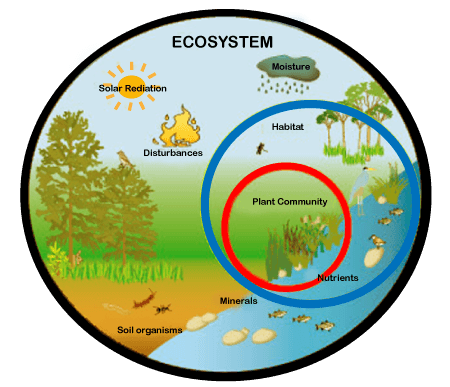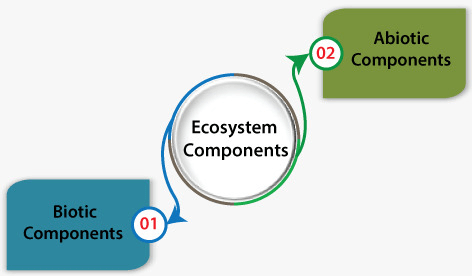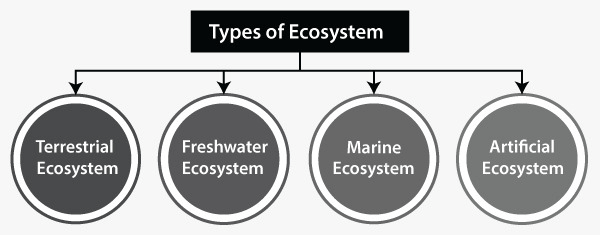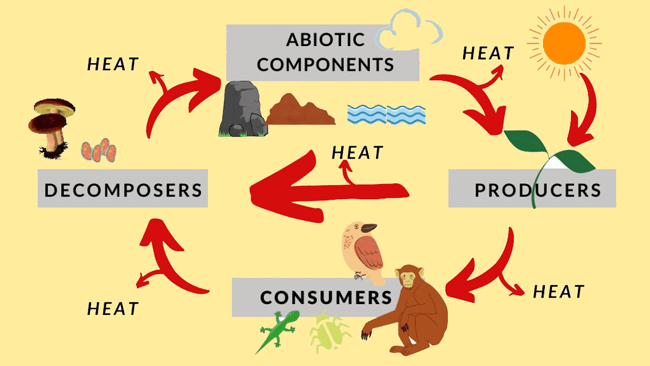What is Ecosystem?An ecosystem is a community of living organisms in conjunction with their environment's non-living components, interacting as a system. These biotic and abiotic components are linked together through nutrient cycles and energy flows. Energy enters the system through photosynthesis and is incorporated into plant tissue. Animals play an important role in the movement of matter and energy through the system. They also influence the quantity of plant and microbial biomass present. By breaking down dead organic matter, decomposers release carbon in the atmosphere and facilitate nutrient cycling by converting nutrients stored in dead biomass back to a form used by plants and other microbes. External and internal factors control ecosystems. External factors such as climate, parent material that forms the soil and topography control the overall structure of an ecosystem but are not influenced by the ecosystem. Unlike external factors, internal factors are controlled, for example, decomposition, root competition, shading, disturbance, succession, and the types of species present. 
Ecosystems are dynamic entities. They are subject to periodic disturbances and recovering from some past disturbance. Ecosystems in similar environments located in different parts of the world can do things very differently simply because they have different pools of species present. Internal factors not only control ecosystem processes but are also controlled by them and are often subject to feedback loops. Resource inputs are generally controlled by external processes like climate and parent material. Internal factors control resource availability within the ecosystem. Although humans operate within ecosystems, their cumulative effects are large enough to influence external factors like climate. Biodiversity affects ecosystem functioning, as do the processes of disturbance and succession. Ecosystems provide a variety of goods and services upon which people depend. Ecology, the scientific study of the interactions between populations or between organisms and the environment, can be viewed at the level of an individual, a population, a community, or an ecosystem. Ecology at the individual level is concerned chiefly with the individual organism's physiology, reproduction, and development. At the population level, ecology deals primarily with the attributes and the various factors affecting the population. At the level of community, ecology studies the interactions between populations and community patterns. At the level of an ecosystem, ecology puts all of them together to understand how the system operates as a unit. Thus, ecosystem ecology would be more concerned about energy flow and nutrient cycles than about individual species. Ecosystem ComponentsThe structure of an ecosystem consists of two major components, such as: 
1. Biotic components The biotic components include all the living things. There are two major types of living things, eukaryotes and prokaryotes.
Plants have chloroplasts that enable them to harvest light energy. Then, they take carbon dioxide and water from their environment to convert them into sugar, a biomolecule that can be used to synthesize chemical energy. Because they can produce their food through photosynthesis, they are referred to as the producers. Next to the producers are the primary consumers. They feed on the producers while they serve as a food source to the higher levels of consumers. The animals are examples of consumers. The animals that feed on plants are called herbivores, whereas those that feed on other animals are carnivores. Then, some feed on both plants and animals. They are called omnivores. 2. Abiotic components The abiotic components include all the non-living things, such as rocks, soil, minerals, water sources, and the local atmosphere. Similar to biotic components, the abiotic components also have their ecological role. For example, elements and compounds serve as sources of nutrients. They are essential to the growth and metabolism of an organism. Apart from providing nutrients, they also provide organisms a place to live and thrive. Types of EcosystemThere are four types of ecosystems, terrestrial, freshwater, marine, and artificial. The first three occur naturally in various biomes. The last one is human-made. 
Ecosystems vary in size from the micro-ecosystems to the largest ecosystems, such as ocean ecosystems. 1. Terrestrial Ecosystem: Terrestrial type of ecosystem occurs on land. Examples of land-based ecosystems are forest ecosystems, grassland ecosystems, tundra ecosystems, and desert ecosystems.
2. Freshwater Ecosystems: Freshwater is the aquatic ecosystems that do not contain saltwater. They are home to algae, plankton, insects, amphibians, and fish. There are two major types: lentic and lotic ecosystems.
3. Marine Ecosystem:It is an aquatic ecosystem that contains saltwater. Examples are the ecosystems in seas and oceans.
4. Artificial Ecosystem: It is a human-made system, which can be further classified as terrestrial, freshwater, or marine. An example of an artificial ecosystem is a terrarium. Many human-made ecosystems are built for conservation purposes, aesthetics, and studying biology and ecology. Processes of EcosystemEcosystems are controlled both by external and internal factors. External factors, also called state factors, control an ecosystem's overall structure and how things work within it but are not themselves influenced by the ecosystem. Other external factors that play an important role in ecosystem functioning include time and potential biota. Similarly, the set of organisms that can potentially be present in an area can also significantly affect ecosystems. Ecosystems in similar environments located in different parts of the world can do things very differently simply because they have different pools of species present. Unlike external factors, internal factors in ecosystems control ecosystem processes and also controlled by them. Consequently, they are often subject to feedback loops. While the resource inputs are controlled by external processes like climate and parent material, the availability of these resources within the ecosystem is controlled by internal factors like decomposition, root competition or shading. Other factors like disturbance, succession or the types of species are present in internal factors. 
1. Primary Production Primary production is the production of organic matter from inorganic carbon sources. This mainly occurs through photosynthesis. The energy incorporated through this process supports life on earth, while the carbon makes up much of the organic matter in living and dead biomass, soil carbon and fossil fuels. It also drives the carbon cycle, which influences global climate via the greenhouse effect. Through photosynthesis, plants capture energy from light and combine carbon dioxide and water to produce carbohydrates and oxygen. The photosynthesis carried out by all the plants in an ecosystem is called the gross primary production (GPP). 2. Energy Flow Energy and carbon enter ecosystems through photosynthesis, are incorporated into living tissue, transferred to other organisms that feed on the living and dead plant matter, and eventually released through respiration. The carbon and energy incorporated into plant tissues (net primary production) is either consumed by animals. In contrast, the plant is alive, or it remains uneaten when the plant tissue dies and becomes detritus. In aquatic systems, the proportion of plant biomass that gets consumed by herbivores is much higher. In trophic systems, photosynthetic organisms are the primary producers. The organisms that consume their tissues are called primary consumers or secondary producers. 3. Decomposition Decomposition is a process in which dead organic substances are broken down into simpler organic or inorganic matter such as carbon dioxide, water, simple sugars and mineral salts. This releases nutrients that can then be re-used for plant and microbial production and returns carbon dioxide to the atmosphere, where it can be used for photosynthesis. In the absence of decomposition, the dead organic matter would accumulate in an ecosystem, and nutrients and atmospheric carbon dioxide would be depleted. Decomposition processes can be separated into three categories,
As water moves through dead organic matter, it dissolves and carries with it the water-soluble components. These are then taken up by organisms in the soil, react with mineral soil, or are transported beyond the confines of the ecosystem. Newly shed leaves and newly dead animals have high water-soluble components and include amino acids, sugars and mineral nutrients. Leaching is more important in wet environments and much less important in dry ones. Decomposition rates vary among ecosystems. Three sets of factors govern the rate of decomposition,
Temperature controls the rate of microbial respiration; the faster the microbial decomposition occurs, the higher the temperature. It also affects soil moisture, which slows microbial growth and reduces leaching. Decomposition rates are highest in wet, moist conditions with adequate levels of oxygen. Wet soils tend to become deficient in oxygen, which slows microbial growth. In dry soils, decomposition slows as well, but bacteria continue to grow even after soils become too dry to support plant growth. 4. Nutrient Cycling Ecosystems continually exchange energy and carbon with the wider environment. On the other hand, Mineral nutrients are mostly cycled back and forth between plants, animals, microbes, and the soil. Most nitrogen enters ecosystems through biological nitrogen fixation, is deposited through precipitation, dust, gases or is applied as fertilizer. Since most terrestrial ecosystems are nitrogen-limited, nitrogen cycling is an important control on ecosystem production. Nitrogen fixation was the major source of nitrogen for ecosystems. Nitrogen-fixing bacteria either live symbiotically with plants or live freely in the soil. Some cyanobacteria are also capable of nitrogen fixation. These are phototrophs, which carry out photosynthesis. Like other nitrogen-fixing bacteria, they can either be free-living or have symbiotic relationships with plants. Other nitrogen sources include acid deposition produced through fossil fuels' combustion, ammonia gas, which evaporates from agricultural fields with fertilizers applied to them, and dust. When plant tissues are shed or are eaten, the nitrogen in those tissues becomes available to animals and microbes. Microbial decomposition releases nitrogen compounds from dead organic matter in the soil, where plants, fungi, and bacteria compete for it. Some soil bacteria use organic nitrogen-containing compounds as sources of carbon and release ammonium ions into the soil. This process is known as nitrogen mineralization. Others convert ammonium to nitrate and nitrite ions, a process is known as nitrification. Nitric oxide and nitrous oxide are also produced during nitrification. Under nitrogen-rich and oxygen-poor conditions, nitrates and nitrites are converted to nitrogen gas, a process known as denitrification. Phosphorus, calcium, sulfur, potassium, manganese, and magnesium are other important nutrients. Phosphorus enters ecosystems through weathering. Calcium and sulfur are also produced by weathering, but acid deposition is an important source of sulfur in many ecosystems. Although magnesium and manganese are produced by weathering, exchanges between soil organic matter and living cells account for many ecosystem fluxes. Potassium is primarily cycled between living cells and soil organic matter. 5. Function and Biodiversity Biodiversity plays an important role in ecosystem functioning. This is because ecosystem processes are driven by the number of species in an ecosystem, the exact nature of each species, and the relative abundance of organisms within these species. Ecosystem processes are broad generalizations that take place through the actions of individual organisms. Ecological theory suggests that to coexist, species must have some level of limiting similarity. They must be different from one another in some fundamental way. One species would competitively exclude the other. The addition of species that are ecologically similar to those already present in an ecosystem tends to only have a small effect on ecosystem function. Ecologically distinct species, on the other hand, have a much larger effect. Similarly, dominant species have a large effect on ecosystem function, while rare species tend to have a small effect. Keystone species tend to affect ecosystem function that is disproportionate to their abundance in an ecosystem. Similarly, an ecosystem engineer is any organism that creates, significantly modifies, maintains or destroys a habitat. 6. Dynamics Ecosystems are dynamic entities. They are subject to periodic disturbances and are in the process of recovering from some past disturbance. When a perturbation occurs, an ecosystem responds by moving away from its initial state. The tendency of an ecosystem to remain close to its equilibrium state, despite that disturbance, is termed its resistance. Disturbance also plays an important role in ecological processes. F.Stuart Chapin and coauthors define disturbance as "a relatively discrete event in time and space that alters the structure of populations, communities, and ecosystems and causes changes in resources availability or the physical environment". This can range from tree falls and insect outbreaks to hurricanes and wildfires to volcanic eruptions. Such disturbances can cause large changes in plant, animal and microbe populations and soil organic matter content. The disturbance is followed by succession, a "directional change in ecosystem structure and functioning resulting from biotically driven changes in resources supply. The frequency and severity of disturbance determine the way it affects ecosystem function. A major disturbance like a volcanic explosion and retreat leave behind soils that lack plants, animals or organic matter. Ecosystems that experience such disturbances undergo primary succession. A less severe disturbance like forest fires, hurricanes or cultivation results in secondary succession and a faster recovery. Energy FlowIn ecology, the term productivity refers to the rate of generation of biomass in an ecosystem. It is often expressed in units of mass per volume per unit of time (g m-2 d-1). Productivity may be primary or secondary. Primary productivity refers to the autotrophs' productivity, such as plants, whereas secondary productivity refers to heterotrophs, such as animals. The primary production of biomass is often attributed to plants and algae performing photosynthesis because virtually all energy available to organisms starts with them. 
Energy from the sun is captured by the chloroplasts inside the cells of photoautotrophs. Inside the chloroplast, photons' light energy drives inorganic substrates' conversion into energy reserves, like sugar molecules. Animals have no such pigments to capture light energy that will enable photosynthesis. Therefore, they have to rely on autotrophs or heterotrophs for food. Photosynthesis is a biological process through which plants manufacture their food with light from the sun and inorganic sources. They produce glucose molecules. In turn, the plants serve as a food source for organisms incapable of producing their food. By feeding on these plants, the energy flows from the producer to the consumer. Then, it flows from one consumer to the next. Complex organic molecules in the food, such as carbohydrates, fats, and proteins, are rich sources of energy stored in their chemical bonds. In the presence of oxygen, glucose is processed to synthesize chemical energy (ATP) via cellular respiration. Energy stored in food molecules is released through a series of oxidation reactions. Electrons are passed on from one molecule to another until it reaches the final electron acceptor, oxygen. As the food molecule is fully oxidized, the final byproduct is carbon dioxide, released through transpiration in plant stomata and exhalation in breathing animals. In the absence of oxygen, cells carry out fermentation wherein glucose is broken down to generate ATP and produce lactic acid. Decomposers are the last group of organisms by which energy flows through. They consume the droppings and carcasses of all living things. Ecosystem EcologyEcosystem ecology studies ecosystems' processes and dynamics and how the flow of matter and energy structures natural systems. The study of ecosystems can cover 10 orders of magnitude, from the surface layers of rocks to the planet's surface. German ecologist Ernst-Detlef Schulze and coauthors defined an ecosystem as an area that is "uniform regarding the biological turnover, and contains all the fluxes above and below the ground area under consideration." Threats Caused by Humans
Next TopicSpark Big Data
|
 For Videos Join Our Youtube Channel: Join Now
For Videos Join Our Youtube Channel: Join Now
Feedback
- Send your Feedback to [email protected]
Help Others, Please Share









